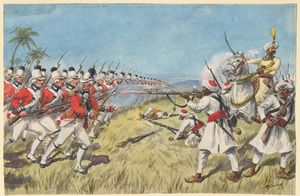Second Mysore War
| Second Anglo–Mysore War | |||||||
|---|---|---|---|---|---|---|---|
| Part of the Anglo-Mysore wars | |||||||
 Depiction of action in the 1783 Siege of Cuddalore. |
|||||||
|
|||||||
| Belligerents | |||||||
|
|
|
||||||
| Commanders and leaders | |||||||
|
|
|
||||||
The Second Anglo–Mysore War was a conflict between the Kingdom of Mysore and the British East India Company from 1780 to 1784. At the time, Mysore was a key French ally in India, and the conflict between Britain against the French and Dutch in the American Revolutionary War sparked Anglo–Mysorean hostilities in India. The great majority of soldiers on the company side were raised, trained, paid and commanded by the company, not the British government. However, the company's operations were bolstered by Crown troops sent from Britain, and by troops sent from Hanover, which was also ruled by Britain's King George III.
Following the British seizure of the French port of Mahé in 1779, Mysorean ruler Hyder Ali opened hostilities against the British in 1780, with significant success in early campaigns. As the war progressed, the British recovered some territorial losses. Both France and Britain sent troops and naval squadrons from Europe to assist in the war effort, which widened later in 1780 when Britain declared war on the Dutch Republic. In 1783 news of a preliminary peace between France and Britain reached India, resulting in the withdrawal of French support from the Mysorean war effort. The British consequently also sought to end the conflict with Mysore, and the British government ordered the Company to secure peace with Mysore. This resulted in the 1784 Treaty of Mangalore, restoring the status quo antebellum under terms company officials such as Warren Hastings found extremely unfavourable.
Hyder Ali ruled Mysore (though he did not have the title of king). Stung by what he considered a British breach of faith during an earlier war against the Marathas, Hyder Ali committed himself to a French alliance to seek revenge against the British. Upon the French declaration of war against Britain in 1778, the British East India Company resolved to drive the French out of India, by taking the few enclaves of French possessions left on the subcontinent. The company began by capturing Pondicherry and other French outposts in 1778. They then captured the French controlled port at Mahé on the Malabar coast in 1779. Mahé was of great strategic importance to Hyder, who received French-supplied arms and munitions through the port, and Hyder had not only explicitly told the British it was under his protection, he had also provided troops for its defence. Hyder set about forming a confederacy against the British, which, in addition to the French, included the Marathas and the Nizam of Hyderabad.
...
Wikipedia
